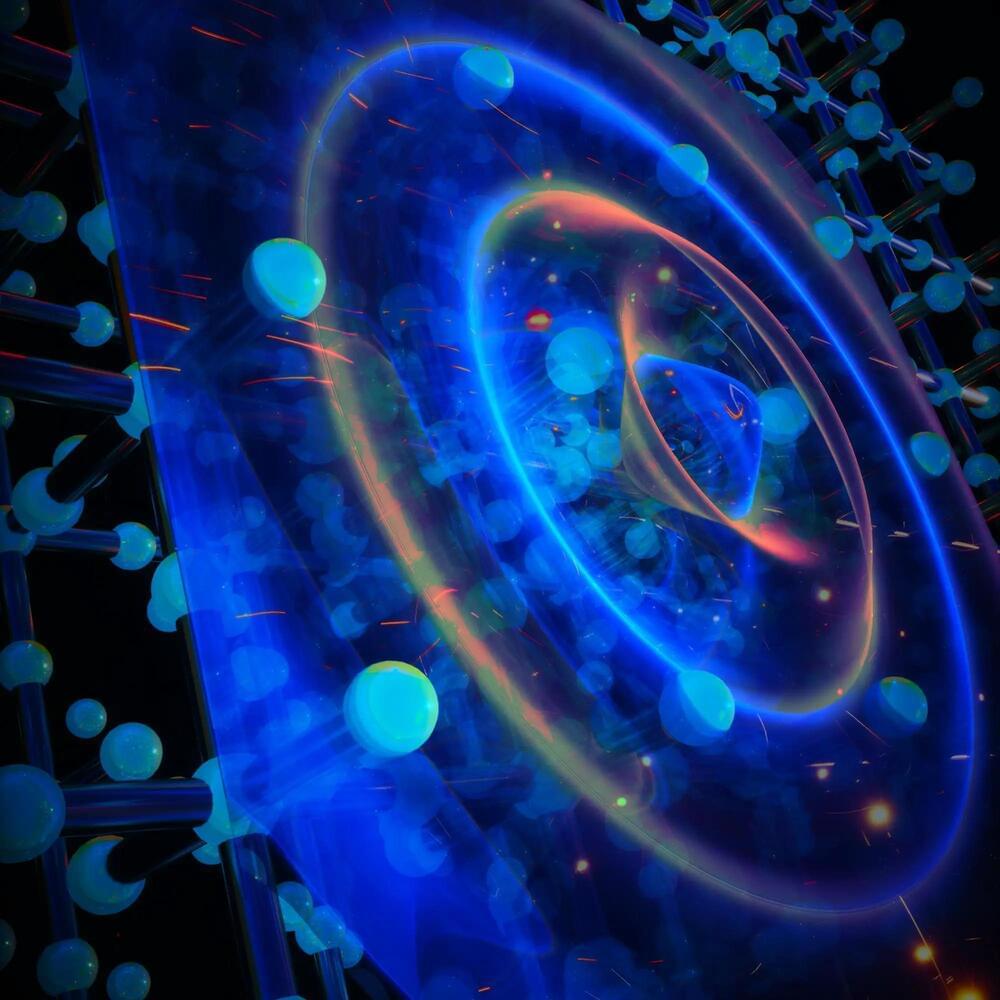Do we all look forward to what lies ahead?



67 years after its theoretical prediction by David Pines, the elusive “demon” particle, a massless and neutral entity in solids, has been detected in strontium ruthenate, underscoring the value of innovative research approaches.
In 1956, theoretical physicist David Pines predicted that electrons in a solid can do something strange. Although electrons typically have a mass and an electric charge, Pines asserted that they could combine to create a composite particle that is massless, neutral, and doesn’t interact with light. He named this theoretical particle a “demon.” Since then, it has been theorized to play an important role in the behaviors of a wide variety of metals. Unfortunately, the same properties that make it interesting have allowed it to elude detection since its prediction.
Fast forward 67 years, and a research team led by Peter Abbamonte, a professor of physics at the University of Illinois Urbana-Champaign (UIUC), has finally found Pines’ elusive demon. As the researchers report in the journal Nature, they used a nonstandard experimental technique that directly excites a material’s electronic modes, allowing them to see the demon’s signature in the metal strontium ruthenate.

Michael Levin talk for the Mind, Technology, and Society (MTS) talk series at UC Merced on January 23, 2023. Abstract: Each of us makes the remarkable journey from the physics and chemistry of a quiescentunfertilized egg to that of a complex human being. How can we understand the continuousprocesses that scale up minds from the tiny physiological competencies of single cells to the large-scale metacognitive capacities of large brains? Here, I will describe a framework known as TAME-Technological Approach to Mind Everywhere — which enables identifying, understanding, andrelating to unconventional cognitive agents. I will use the example of the collective intelligence ofcells during morphogenesis to illustrate how we can begin to widen the lessons of multiscale neuroscience well beyond neurons. This will be essential as we head into a future that will bepopulated by a wide range of evolved, designed, and hybrid beings with novel bodies and novelminds. I will conclude with a case study of our new synthetic biorobot (Xenobots) and a discussionof the implications of these ideas for evolution, biomedicine, and ethics.
Consciousness is usually ascribed to a specific set of mechanisms and functional capabilities of the complex brain. Importantly, those mechanisms (ion channels, electrical networks, neurotransmitter machinery) long pre-date the evolutionary innovation of nervous systems. Moreover, the algorithms and competencies such as memory, decision-making, and information integration likewise have an ancient evolutionary origin: before they controlled moving the body through 3D space, electrical networks moved body configurations through anatomical morphospace. In this talk, I will describe how we view the morphogenesis during embryonic development and regeneration as the behavior of a collective intelligence, which has many problem-solving capacities. I will describe the tools we have developed, paralleling neuroscientists’ attempts to read and write mental content by control of electrophysiology, to decode and re-write the pattern memories of the body. This has significant implications not only for biomedicine and evolutionary biology, but also for questions about consciousness and the scaling of coherent Selves from agential materials. I will conclude with some conjectures about what this new field offers the science of consciousness, in the form of new embodied living creatures that are outside the natural evolutionary stream of Earth, and the quest for theories of consciousness.-https://www.drmichaellevin.org/ Participate in our online research survey-Survey on Diverse intelligence-https://tufts.qualtrics.com/jfe/form/SV_eE51vKE34q3hexo (takes 9 minutes). Thank you.
Edited by Emilio Manzotti.
https://github.com/emilim/
Nanotechnology is without a doubt one of the most exciting future technologies, but what is it exactly? And how will it benefit mankind? Well sit back and get comfy because in todays video, we will be answering all of those questions and more!IPhone wireless charging cases — https://amzn.to/3bz0oRg.
IPhone Backup — https://amzn.to/3w8Usbj.
Wireless Earbuds — https://amzn.to/2ZTjwau.
IPhone Bargains — https://amzn.to/3jXvCGb**** Gears and Equipment we use****
1. Fully Automatic Espresso Machine — https://amzn.to/3bdHcbr.
2. Perfect Desk Chair — https://amzn.to/2ZlMNd2
3. Wireless Mechanical Keyboard — https://amzn.to/3pA71Lw.
4. Wireless DTS Headphone — https://amzn.to/3juz2Qv.
5. Vocal Microphone — https://amzn.to/2XEDsN4
6. UltraWide Monitor — https://amzn.to/3jyteWg**** Free Handy Tools YOU must try ****Tubebuddy In-depth channel/video analysis– https://bit.ly/3y0SOc6
Amazon Prime — https://amzn.to/3mb0BzG
Epidemic Music — https://bit.ly/3FDplbT
Fiverr — Freelance Marketplace — https://bit.ly/3FFARnL
Here at Future Now we aim to bring you the most informative, fascinating and engaging Technology videos on YouTube.🔔 Subscribe To Our Channel: https://bit.ly/3nRoVH8
Copyright Disclaimer:
Under section 107 of the Copyright Act 1976, allowance is made for “fair use” for purposes such as criticism, comment, news reporting, teaching, scholarship, education and research. Fair use is a use permitted by copyright statute that might otherwise be infringing. Non-profit, educational or personal use tips the balance in favor of fair use. *DISCLOSURE*
We are affiliated, but not sponsored by any product featured in this video.
Some links in the description are affiliate links to products, which means if you click on them and buy the product, we will receive a small commission.
Not being sponsored allows us to keep our own opinions and provide product reviews without bias. From the millions of products, we appreciate your support.#NanoTech #Nanotechnology #NanoTechHacking

Conclusions: Most studies demonstrated the use of VR to be effective for supporting the treatment of anxiety or depression in a range of settings and recommended its potential as a tool for use in a clinical environment. Even though standalone headsets are much easier to work with and more suitable for home use, the shift from tethered VR headsets to standalone headsets in the mental health environment was not observed. All studies that looked at the use of CBT either in vivo or in a virtual environment found it to be effective in supporting the treatment of anxiety or depression.
Keywords: CBT; anxiety; depression; mental health; virtual reality.
©Nilufar Baghaei, Vibhav Chitale, Andrej Hlasnik, Lehan Stemmet, Hai-Ning Liang, Richard Porter. Originally published in JMIR Mental Health (https://mental.jmir.org), 23.09.2021.
Like this video about how Viva Vita addresses loneliness and depression in the elderly using VR. Subscribe here: https://freeth.ink/youtube-subscribe-depressionintheelderly.
Watch the next video in our series on virtual reality therapy: https://youtu.be/IZE41KejIBw.
In the United States, about six million people over the age of 65 experience late life depression and about one-third of seniors feel lonely.
Viva Vita is taking a novel approach to addressing both loneliness and depression in the elderly population.
The organization provides virtual reality excursions for seniors to help them break through personal limitations and find enjoyment exploring new settings.
At first glance, virtual reality for seniors might seem like a gimmick, but early studies of VR for depression, chronic pain, and other ailments are quite promising.
What happens when humans begin combining biology with technology, harnessing the power to recode life itself.
What does the future of biotechnology look like? How will humans program biology to create organ farm technology and bio-robots. And what happens when companies begin investing in advanced bio-printing, artificial wombs, and cybernetic prosthetic limbs.
Other topic include: bioengineered food and farming, bio-printing in space, new age living bioarchitecture (eco concrete inspired by coral reefs), bioengineered bioluminescence, cyberpunks and biopunks who experiment underground — creating new age food and pets, the future of bionics, corporations owning bionic limbs, the multi-trillion dollar industry of bio-robots, and bioengineered humans with super powers (Neo-Humans).
As well as the future of biomedical engineering, biochemistry, and biodiversity.
_______
Created by: Jacob.
Narration by: Alexander Masters (www.alexander-masters.com)
Modern Science Fiction.
The Conversation Weekly podcast is taking a short break in August. In the meantime, we’re bringing you extended versions of some of our favourite interviews from the past few months.
This week, how researchers discovered a biological switch that could turn on and off neuroplasticity in the brain – the ability of neurons to change their structure. We speak to Sarah Ackerman, a postdoctoral fellow at the Institute of Neuroscience and Howard Hughes Medical Institute at the University of Oregon, about what she and her team have found and why it matters.
This episode of The Conversation Weekly features an extended version of an interview first published on April 29. The Conversation Weekly is produced by Mend Mariwany and Gemma Ware, with sound design by Eloise Stevens. Our theme music is by Neeta Sarl. You can sign up to The Conversation’s free daily email here. Full credits for this episode available here.
Further reading: Astrocyte cells in the fruit fly brain are an on-off switch that controls when neurons can change and grow, by Sarah DeGenova Ackerman, University of OregonSwimming gives your brain a boost – but scientists don’t know yet why it’s better than other aerobic activities, by Seena Mathew, University of Mary Hardin-BaylorWhat is brain plasticity and why is it so important?, by Duncan Banks, The Open University.